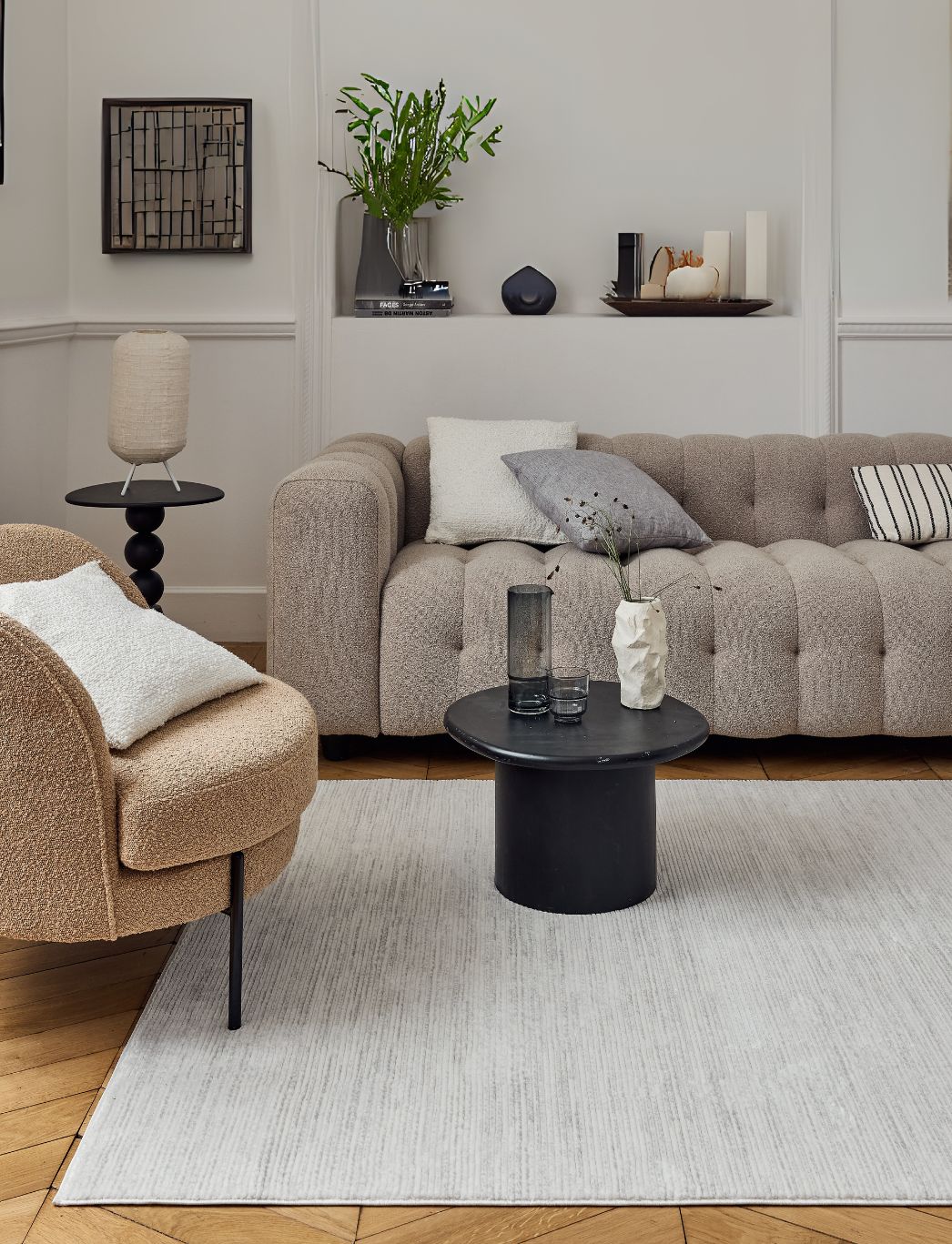The Global Influence of Handwoven Textiles
A true example of sustainability in style is handwoven fabrics.
Handwoven textiles hold a timeless and unique charm that surpasses cultures and borders. They are more than just fabrics. They are a testament to human skill, creativity, and cultural heritage.

Weaving can be traced back to the Palaeolithic Era, around 27,000 years ago. It was used to make cordage types, sophisticated plaited basketry, and plane cloths. Ancient civilizations who adopted it first include the Egyptians, Greeks, and Chinese. These textiles were symbolic and carried deep religious and cultural significance. In many societies, weaving was considered a sacred art, and the weavers held esteemed positions in their communities.
Handwoven textiles include a wide range of woven fabrics that are formed by two elements: Weft and warp – using a loom, which is a device that maintains tension on the warp. The loom is either computer-driven, mechanized, or primitive. All of these are considered handloom if a weaver operates the device.
Today, power looms have taken the place of cultural textile traditions, but woven art persists in various parts of the world.

Cultural Significance
Handwoven textiles have deep-rooted cultural significance in many parts of the world. They are often tied to the history of a particular region. For example, Iran is well known for their Persian rugs, and Turkey for their Oushak rugs.
The art of handweaving dates back thousands of years and is passed down through generations. Each region boasts its distinct textile craftsmanship, patterns, and motifs, making it a powerful representation of cultural and textile diversity within the country.

The Impact of Handwoven Textiles on the Fashion Industry
Handloom and sustainability go hand in hand. This environmentally-friendly technique to make eco-friendly clothes has allowed brands to market their designs in a different light. For example, Pakistani rugs are made from the wool of Merino sheep, which offers numerous advantages, such as good insulation and anti-static and moisture-transporting properties.
One of the reasons handwoven textiles are sought after in the fashion industry is because of their exclusivity. These fabrics are often created in limited quantities, making them unique. The high price tag makes them a luxurious item that only a few people can afford. Designers collaborate with skilled weavers to create custom textiles that reflect their values and vision.

Promoting Sustainable Practices
Unlike mass-produced fabrics, handwoven textiles are typically made from natural fibres, such as cotton, silk, or wool. These fibres are biodegradable and have a lower environmental impact compared to synthetic alternatives.

Handwoven textiles involve manual labour and traditional techniques that minimize the use of chemicals and machinery. As a result, less energy is consumed. Moreover, with fewer harmful emissions, the textile industry meets the global initiatives set to combat climate change. This is how the fashion industry reduces its carbon footprint.
In most countries, handwoven textures are produced in rural areas, providing communities with livelihoods and incomes. This supports sustainable development and provides more economic opportunities.
One of the most important aspects of handwoven textiles is the craftsmanship. It takes months or years to create a single piece. The love, care, and skill that goes into the production gives it longevity.
These textiles are known for their timeless appeal. Unlike fast fashion items, which are discarded after a couple of uses, handwoven items last for generations.
On a personal level, handwoven textiles impact our well-being. Whether in the form of clothing, accessories, or hand décor, they are a form of self-expression. From their textures to colours and patterns, they reflect our taste and allows us to showcase our unique identity.

Shop The Rugs: Handwoven Rugs for Every Style
Looking for quality handwoven textiles to decorate your home? Visit The Rugs website and browse their wide range of rug collections by style, size, colour, and room.
People Also Asked
What is the global impact of textiles?
Textiles have a significant global impact, influencing economies, cultures, and the environment. The industry provides millions of jobs worldwide but also contributes to environmental challenges like water pollution and carbon emissions. Textiles play a crucial role in international trade and shape fashion trends across cultures.
What is the importance of textiles in culture?
Textiles are vital cultural artifacts, reflecting a society's traditions, beliefs, and artistic expressions. They serve as symbols of identity, play roles in religious and social rituals, and often preserve historical narratives. Textiles also facilitate cultural exchange and influence fashion and design across different societies.
What are artisanal textiles?
Artisanal textiles are handcrafted fabrics made using traditional techniques and often local materials. These textiles showcase unique cultural heritage and skilled craftsmanship, typically produced in small batches or as one-of-a-kind pieces. Artisanal textiles often feature intricate designs and support local economies and sustainable practices.
What is a hand woven textile?
A hand woven textile is fabric created on a loom operated manually by a skilled weaver. This process involves interlacing warp and weft threads to form a fabric without the use of powered machinery. Hand woven textiles often possess unique textures, patterns, and irregularities that contribute to their charm and value.
How textiles changed the world?
Textiles revolutionized human civilization by providing better protection from the elements, enabling long-distance trade, and spurring technological innovations. The textile industry played a crucial role in the Industrial Revolution, transforming economies and societies. Textiles also facilitated cultural exchange and influenced art, fashion, and social structures globally.
Why is the global textile industry important?
The global textile industry is important because it:
- Provides millions of jobs worldwide
- Contributes significantly to international trade
- Drives technological innovations
- Influences fashion and cultural trends
- Supports economic development in many countries
- Plays a role in addressing sustainability challenges
What is globalization in textiles?
Globalization in textiles refers to the interconnected nature of the textile industry across borders. It involves the international sourcing of raw materials, distributed manufacturing processes, and global marketing and distribution of textile products. This phenomenon has led to complex supply chains, increased competition, and the spread of fashion trends worldwide.
What are the impact of textile in our society?
Textiles impact our society by:
- Providing essential clothing and household items
- Creating employment opportunities
- Influencing fashion and personal expression
- Contributing to economic growth
- Shaping cultural identities and traditions
- Driving technological advancements
- Raising environmental awareness and sustainability concerns
Why are textiles important to our society?
Textiles are important to our society because they:
- Fulfill basic human needs for clothing and shelter
- Serve as mediums of artistic expression
- Preserve cultural heritage and traditions
- Drive economic activity and innovation
- Enable personal and social identity expression
- Contribute to comfort and well-being in daily life
- Raise awareness about sustainability and ethical production
What is the global textile trade?
The global textile trade involves the international exchange of textile products, including raw materials, fabrics, and finished goods. It's characterized by complex supply chains, diverse production centers, and varying trade agreements. This trade significantly impacts national economies, influences labor markets, and shapes consumer trends worldwide.
How does globalization affect clothing?
Globalization affects clothing by:
- Enabling fast fashion and rapid trend cycles
- Creating complex international supply chains
- Increasing access to diverse styles globally
- Impacting local textile traditions and industries
- Raising concerns about labor conditions and sustainability
- Facilitating the spread of fashion trends across cultures
- Driving competition and price fluctuations in the market
What is the impact of textile design?
Textile design impacts:
- Fashion trends and consumer preferences
- Cultural expression and identity
- Functionality of clothing and home textiles
- Sustainability through material choices and production methods
- Economic value of textile products
- Technological innovations in fabric production
- Artistic and creative industries
What are the five importance of textile?
Five key importances of textile are:
- Protection from environmental elements
- Economic significance in global trade and employment
- Cultural expression and preservation of traditions
- Technological innovation driving industrial progress
- Personal expression through fashion and design
Why are textiles important in history?
Textiles are important in history because they:
- Reflect technological advancements of civilizations
- Serve as artifacts preserving cultural information
- Played a key role in trade and economic development
- Influenced social structures and class distinctions
- Contributed to artistic and cultural expressions
- Drove industrial revolutions and economic shifts
- Provide insights into daily life of past societies
Why do textiles matter?
Textiles matter because they:
- Fulfill essential human needs for protection and comfort
- Drive economic activity and employment globally
- Preserve and express cultural identities
- Influence fashion and personal expression
- Contribute to technological innovations
- Raise awareness about sustainability and ethical production
- Shape social interactions and personal well-being
What is the most important thing in textile industry?
The most important aspects of the textile industry include:
- Sustainability and environmental responsibility
- Innovation in materials and production processes
- Quality control and product standards
- Ethical labor practices and fair trade
- Efficient supply chain management
- Meeting consumer demands and trends
- Adapting to technological advancements
Why is textiles important in art?
Textiles are important in art because they:
- Serve as a versatile medium for artistic expression
- Preserve cultural traditions and techniques
- Blend functionality with aesthetics
- Challenge perceptions of art vs. craft
- Offer unique tactile and visual experiences
- Reflect social and historical contexts
- Inspire innovation in materials and techniques
Why was the textile industry important?
The textile industry was important because it:
- Drove the Industrial Revolution
- Created mass employment opportunities
- Spurred technological innovations
- Facilitated global trade and economic growth
- Influenced social and labor movements
- Enabled mass production of clothing and household items
- Shaped urbanization and demographic shifts
What is globalization in textile industry?
Globalization in the textile industry involves:
- International sourcing of raw materials
- Distributed manufacturing across countries
- Global supply chains and logistics networks
- Cross-border trade of textile products
- Spread of fashion trends worldwide
- Technology and knowledge transfer between regions
- Competition and collaboration on a global scale
What are three environmental impacts of the textile industry?
Three major environmental impacts of the textile industry are:
- Water pollution from dyeing and treatment processes
- High carbon emissions due to energy-intensive production
- Textile waste contributing to landfill and pollution issues
How much textile waste globally?
Globally, the textile industry produces an estimated 92 million tonnes of waste annually. This includes:
- 18 million tonnes of leftover textiles
- 2.5 million tonnes of chemical waste
- 3 million tonnes of packaging materials
The fashion industry alone contributes significantly, with projections suggesting an increase to 134 million tonnes of textile waste by 2030 if current trends continue. This massive waste production highlights the urgent need for sustainable practices and improved waste management in the textile industry.
What is the global textile industry?
The global textile industry is a vast, interconnected network of producers, manufacturers, and retailers involved in creating and distributing textile products worldwide. It encompasses:
- Raw material production (natural and synthetic fibers)
- Fabric manufacturing
- Garment and textile product creation
- Distribution and retail
- Recycling and waste management
This industry significantly impacts global economies, employment, and environmental sustainability.
What is globalization of fashion?
Globalization of fashion refers to the worldwide interconnectedness of fashion trends, production, and consumption. Key aspects include:
- Rapid spread of fashion trends across cultures
- Internationalized supply chains for production and distribution
- Global marketing and brand presence
- Cross-cultural influences on design and style
- Fast fashion phenomenon accelerating production and consumption cycles
- Increased accessibility to diverse fashion choices worldwide
- Challenges in sustainability and ethical production practices
What are the biggest textile polluting nations?
The biggest textile polluting nations are:
- China - Produces about 20 million tonnes of fashion waste annually
- United States - Generates approximately 17 million tonnes of fashion waste
- India - Contributes 7.8 million tonnes of fashion waste
- Italy - Produces 465,925 tonnes of fashion waste
- Germany - Generates 391,752 tonnes of fashion waste
These countries are major textile producers and consumers, contributing significantly to global textile pollution through manufacturing processes and post-consumer waste.
What is the global impact of cotton?
Cotton has a significant global impact:
- Water consumption: Producing one cotton t-shirt requires about 2,700 liters of water
- Land use: Cotton cultivation demands extensive agricultural land
- Chemical use: Pesticides and fertilizers in cotton farming affect soil and water quality
- Economic importance: Provides livelihoods for millions, especially in developing countries
- Trade significance: Major component of global textile trade
- Environmental concerns: Contributes to water scarcity and pollution in production regions
- Genetic modification debates: Use of GM cotton raises ecological and ethical questions
- Sustainability challenges: Drives efforts for more sustainable farming and processing methods
What are the health impacts of textile industry?
The textile industry has several health impacts:
- Chemical exposure: Workers face risks from dyes, solvents, and finishing agents
- Respiratory issues: Dust and fiber particles can cause lung problems
- Skin irritations: Contact with chemicals and fibers may lead to dermatological conditions
- Noise pollution: Factory machinery can cause hearing damage
- Musculoskeletal disorders: Repetitive tasks and poor ergonomics affect workers' physical health
- Water pollution: Contaminated water sources impact community health in production areas
- Microfiber pollution: Synthetic textiles release microplastics, potentially entering the food chain
- Mental health: Poor working conditions and pressure in fast fashion can affect psychological well-being
What is green technology in the textile industry?
Green technology in the textile industry refers to environmentally friendly innovations aimed at reducing the industry's ecological footprint. Key aspects include:
- Water-saving technologies in dyeing and finishing processes
- Energy-efficient machinery to reduce carbon emissions
- Organic and recycled fibers to minimize resource consumption
- Closed-loop production systems for waste reduction and resource recovery
- Bio-based dyes and chemicals to reduce toxic pollutants
- Advanced waste treatment methods for effluent management
- Smart textiles designed for longevity and recyclability
- 3D printing technologies to reduce material waste in production
These technologies aim to create a more sustainable and eco-friendly textile industry.
Why are textiles important?
Textiles are important because they:
- Provide essential protection and comfort in clothing and shelter
- Play a crucial role in global economies and employment
- Serve as mediums for cultural expression and identity
- Drive technological innovations across various industries
- Contribute to personal and social well-being through fashion and design
- Have significant historical and archaeological value
- Raise awareness about sustainability and ethical production practices
- Influence art, design, and creative industries
- Meet diverse functional needs in industries like healthcare and transportation
- Foster international trade and cultural exchange
Their ubiquity in daily life and far-reaching impacts make textiles a fundamental aspect of human civilization.
What is the process of handwoven?
Handweaving is a meticulous craft that involves interlacing threads to create fabric. The process begins with setting up the warp threads on a loom, which are then interwoven with weft threads using various techniques. Weavers manipulate these threads by hand, often using shuttles or other tools, to create intricate patterns and textures. The tension and spacing of threads are crucial for achieving the desired fabric quality.
How are woven fabric made step by step?
Woven fabrics are created through a systematic process. It starts with fiber selection and preparation, followed by spinning these fibers into yarn. The yarn is then wound onto bobbins for the warp and weft. Next, the warp threads are set up on the loom in a process called warping. The weaver then passes the weft thread over and under the warp threads in a specific pattern, a process known as shedding. This is repeated, with each pass of the weft called a pick, until the desired length of fabric is achieved.
What is handwoven textile?
Handwoven textiles are fabrics created using traditional weaving techniques without the aid of powered machinery. These textiles are characterized by their unique textures and patterns, often reflecting cultural heritage and individual craftsmanship. Handwoven fabrics can range from simple plain weaves to complex jacquard designs. The process allows for greater control over the fabric's characteristics, resulting in high-quality, often one-of-a-kind pieces.
How is fabric made by hand?
Fabric made by hand involves several stages of manual labor. It begins with raw fiber preparation, which may include cleaning, carding, and combing. These fibers are then spun into yarn using tools like spindles or spinning wheels. The yarn is prepared for weaving by winding it onto bobbins or spools. The weaving process itself involves setting up the loom with warp threads and then interlacing them with weft threads using various hand techniques. The final steps may include finishing processes like washing, pressing, or embellishing the fabric.
What is the hand weaving technique?
Hand weaving techniques encompass a variety of methods used to create fabric without powered looms. The most basic technique is plain weave, where weft threads pass over and under alternating warp threads. More complex techniques include twill, satin, and tapestry weaves. Weavers use tools like shuttles, heddles, and beaters to manipulate threads and create patterns. The choice of technique depends on the desired fabric structure, pattern complexity, and cultural traditions.
What is the difference between handloom and handwoven?
While often used interchangeably, there is a subtle difference between handloom and handwoven fabrics. Handloom specifically refers to fabric woven on a manually operated loom, which may have some mechanical components but is not powered. Handwoven, on the other hand, is a broader term that encompasses any fabric woven by hand, including those made on simpler frame looms or even without a loom. All handloom fabrics are handwoven, but not all handwoven fabrics are necessarily made on a handloom.
What is the process of weaving in textile?
The weaving process in textile production involves interlacing two sets of yarns at right angles. It begins with warp preparation, where long yarns are arranged parallel on the loom. The weaver then passes the weft yarn over and under the warp yarns in a specific pattern. This is achieved through the shedding process, where some warp yarns are raised while others are lowered, creating a space (shed) for the weft to pass through. The weft is then beaten into place, and the process is repeated to form the fabric.
How is basic woven fabric constructed?
Basic woven fabric is constructed through the interlacing of two perpendicular sets of yarns. The longitudinal yarns, called the warp, are held taut on the loom. The transverse yarns, known as the weft or filling, are passed over and under the warp yarns. The simplest construction is the plain weave, where each weft yarn goes over one warp yarn, then under the next, alternating across the fabric width. This basic structure can be varied to create different patterns and textures in the fabric.
What is the process of handloom fabric manufacturing?
Handloom fabric manufacturing is a traditional process that begins with yarn preparation. The chosen yarns are wound onto bobbins for the warp and weft. The warp threads are then arranged on the loom in a process called warping. The weaver operates the loom manually, using foot pedals to control the heddles that raise and lower warp threads. The weft yarn is passed through the shed using a shuttle, and then beaten into place. This process is repeated, with the weaver carefully controlling tension and pattern to create the desired fabric. The final steps may include finishing processes like washing or ironing to enhance the fabric's appearance and feel.
Related Blog Posts
December Dreams: Rugs Inspired by the Winter Night Sky
Related Rug Collections










Leave a comment